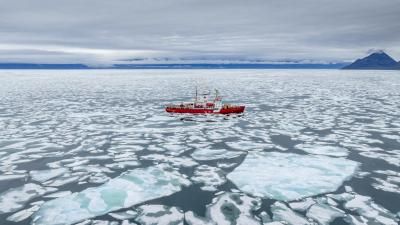
Marine heatwaves and sea ice: implications for Arctic navigational safety
In this blog, Dr Bahareh Kamranzad discusses how her research will support Arctic navigational safety in a rapidly changing climate.
This page is approximately a 4 minute read
This page was published on

Claudio Aporta, Professor, Canadian Chair, Marine Environmental Protection, World Maritime University
Anish Hebbar , Associate Professor, World Maritime University
The industrial whaling era of the late 19th and early 20th centuries was a defining period for Arctic shipping, with impacts extending beyond the maritime domain.
Whaling was transformative for Arctic Indigenous inhabitants (Inuit), as whalers were among the first outsiders to spend extended periods in the region, wintering to take advantage of favourable sailing and hunting conditions. The interactions between Inuit and whalers brought significant changes to Inuit communities, while whalers gained valuable knowledge about safety, ice navigation, and the geography and environment of parts of the Arctic that were largely uncharted. Additionally, industrial whaling profoundly affected Arctic ecosystems, nearly driving bowhead whales to extinction.
In the eastern Canadian Arctic, particularly in Hudson Strait, Hudson Bay, and Foxe Basin, industrial whaling was especially intense, with 150 voyages between 1860 and 1915. Most whaling ships to that area came from the American ports of New Bedford and New England, and from the Scottish port of Dundee. The whaling boom was driven by substantial economic incentives, including the trade of whale oil (used for lighting, lubrication, and other industrial purposes) and baleen, which was essential for producing items like corsets, umbrella ribs, buggy whips, and industrial springs.
The whaling period also occurred during a shift in shipping practices, transitioning from wind to steam-powered vessels. By the early 20th century, the whaling era waned due to several converging factors, including the decline of whale populations and technological advancements that reduced the economic and practical value of whale products.
These 150 voyages (along with other whaling in the Arctic) facilitated significant exchanges of knowledge and material culture between whalers and Inuit, transforming Inuit residence patterns, hunting techniques, and diet. However, these interactions also introduced endemic problems, such as alcohol and diseases, to which the local population had no immunity. Moreover, the voyages generated both accurate and distorted information about the Arctic, shaping the public imagination of the region and its inhabitants.
While Inuit were often employed or engaged by whalers as part of the whaling crews, including as interpreters, cartographers and navigators, their contributions to shipping and Arctic exploration are poorly understood and scarcely acknowledged. Inuit knowledge enhanced the geographic understanding of the Arctic, as well as ice navigation techniques, understanding of seasonal changes, and the wellbeing of seafarers through the improvement of clothing and diet.
Thanks to our fellowship with Lloyd’s Register Foundation and UArctic, we are now able to conduct research to improve our understanding of Inuit-whaler interactions, with a particular focus on maritime-related knowledge exchanges and their implications in Arctic shipping safety.
Our study – ‘Learnings from historical shipping accidents and ships-Inuit encounters: an examination of whaling in Arctic Canada’ – will also examine the intersections between shipping transits and Inuit traditional mobility, and analyse shipping accidents and incidents during the 1860-1915 whaling period.
The project will seek to answer three primary research questions:
These questions will be investigated using a qualitative analysis of Inuit-whaler encounters, primarily using published historical records and previously documented Inuit knowledge. These will be drawn from sources such as the Whaling Archives in Dundee, the New Bedford Whaling Museum Archives, and the Mystic Seaport Museum Collections and Research Centre, as well as the archives of Lloyd’s Register Foundation and the Royal Society.
In order to analyse marine casualties and incidents during the relevant historical period, we will employ the International Maritime Organization’s Maritime Casualties and Incidents taxonomy. All this information will be used to develop an interactive map showcasing trajectories of whaling ships, interactions between Inuit communities and whalers, and locations of major shipping accidents.
By drawing lessons from the past, this research will explore how Arctic shipping safety and Inuit engagement in maritime governance can be improved today.
If you would like to find out more about this project, you can get in touch with the research fellows at ca@wmu.se.

